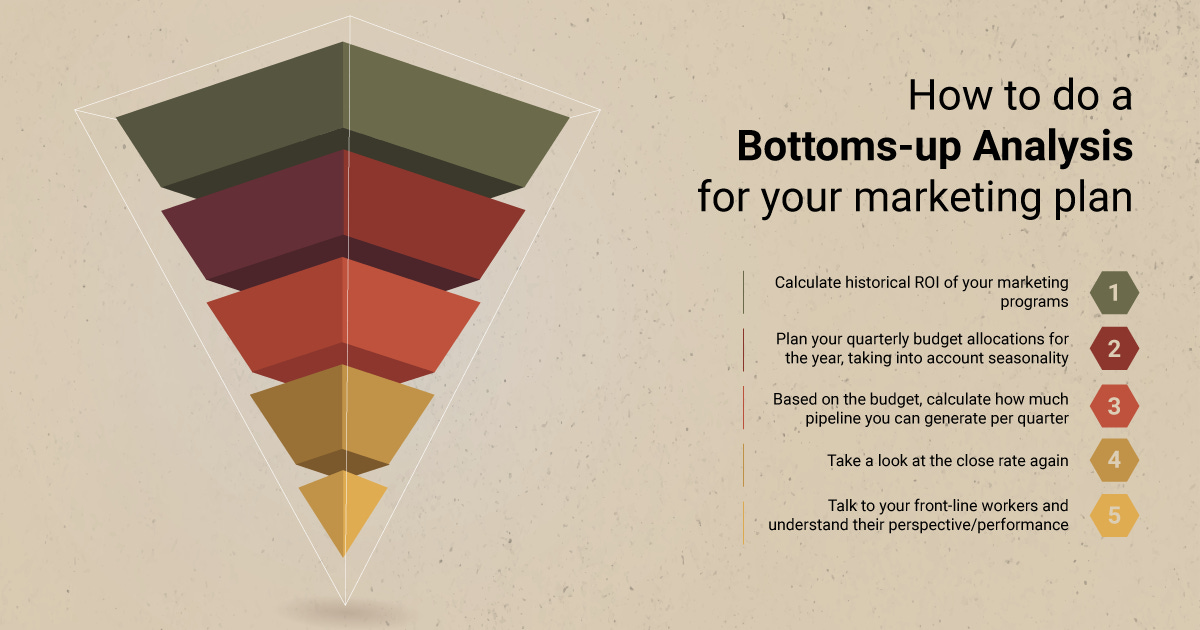by SEBASTIAN CUERVO AND CRISTINA DAROCA for 42 Slash
Every professional marketer eventually gets closer to owning and worshiping a particular number. Number of leads, number of opportunities, MQLs, SQLs, SALs, and so on. Ultimately, it all comes down to revenue, and more importantly, success in marketing is about understanding systems.
We had a great conversation with Cristina Daroca, where we went over how she does top-down AND bottoms-up analysis to develop annual marketing plans. Before we dive into the tactical aspects of this piece, this is also an excellent opportunity to reconsider the importance of risk in your marketing campaigns.
Risk matters

Marketers love being able to predict outcomes, whether it’s investing more in a particular channel, hiring an external agency to own a function, or restructuring the team to meet the targets. Once we have a clear plan and numbers to back it up, we can breathe. We feel confident we will hit the numbers every month.
This growth model/mindset can be boiled down to numbers in excel. We add funnel stages and conversion rates, and make sure we promise targets we can deliver. The job becomes to minimize risk and produce predictable outcomes, and as marketers we reduce complexity into % we can understand, alter, and scale.
Out the window are the risky angles and emotions. JTBD, pain points, features and logic drive marketing efforts.
But, that comes at a cost.
It’s not like B2B SaaS marketers aren’t aware of the iconic works of Ogilvy or the fact that Mad Men is more than a fictional series. It’s more about the structural revenue systems we have created where our work is defined exclusively by moving the needle. Month over month we must hit the target, so we do what we think has higher chances of working (until it doesn’t). The pressure is unbearable, but with numbers risk becomes less crushing and uncertainty less , and investors love it!
Should they though? Is incremental data-driven marketing enough? Is there a limit to doing only what works to meet targets?
Previously we discussed the importance of brand and how data is ultimately not a reflection of your organization but of your past. Data matters, no one can say otherwise. But brand efforts without a direct or immediate response are also important and often overlooked because they fall outside what your data model says. Our colleagues from HockeyStack in this episode from their series Level Up, explore how B2B SaaS can never truly be differential or disruptive. We somewhat agree. Pushing for true originality is almost impossible in B2B. It is difficult for marketers to justify investments except those tied directly back to revenue. But if we never take risks, how can we push the boundaries? Are “media” plays the only alternative we can push for to justify investments outside the box?
We don’t think so.
Chaos and innovation go hand in hand. It is not a coincidence that some of the most brilliant minds in entrepreneurship and innovation publicly claim chaos as a determinant factor for their success. The marketing game of entrepreneurship, especially in B2B, is a more risk-averse and feature-based style of marketing. Ironically, this rigid version of avoiding taking risky chances might stifle growth and revenue— plus, whatever marketing strategy worked for X would not work for Y.
Embrace risk. That’s also the beauty of marketing. It requires you to be a statistician, and an artist.
Once you are ready, remember people value publicity, and build marketing plans that allocate some budget to bold experiments. And, of course, adopt the following marketing plan views to build a solid foundation for your work.
How to do a 𝙏𝙤𝙥-𝙙𝙤𝙬𝙣 𝙖𝙣𝙖𝙡𝙮𝙨𝙞𝙨 for your marketing plan

A top down analysis is all about taking your top goal (usually in sales) and cascade it down to find the leading indicators you should prioritize (pipeline, meetings, funnel metrics). In this part of the planning process you are looking for numbers & conversion rates all the way to closed won.
Note: These indicators might change given your company, the type of Go-to-market strategy you use, or simply the product you are marketing. Rather than having a one-size-fits-all approach, take the time to understand the top goal and the metrics that will help you determine how close (or how far) you are from meeting that goal.
- Figure out the quarterly sales quota your sales team has. Beyond the obvious exercise of understanding what they are working with, also understand the way they are structured internally. The type of incentives they value, the culture and different types of people they have in their team. It’s not just about the quota, it’s about aligning the team to achieve the goals.
- Identify all channels, efforts, and activities that are currently in place both in marketing and sales to meet yearly goals. Justifying a yearly plan means you have into consideration all of the different activities and experiments that are happening across revenue-generating functions of the business. This may vary depending on your organization and model (for example, in PLG models may not have sales but rather a CX department that has a massive impact on sales conversions)
- Identify the pipeline coverage the business needs to hit that quota. Have a clear picture of the closed-won metric to be able to determine how much effort is required to meet pipeline coverage. So for example, if your close rate is 25%, you need 4x coverage.
- Calculate your funnel metrics based on historical conversion rates. Analyze the conversion rates at each stage of your sales funnel, such as lead-to-opportunity or opportunity-to-customers. Use historical data to determine the average conversion rates for each stage.
- Identify what are the levers that will help you drive internal organizational alignment: You are working with multiple teams of individuals, meaning you need to understand how each department works and how you can help them by having a clear plan. Talk to departamental leaders and see what their challenges are, how they interact with one another, and how to help them streamline operations. Ultimately, avoiding confrontation, or unhealthy interactions between sales, marketing and CX departments is a large portion of succeeding with this plan.
- Determine how much pipeline marketing is going to contribute to that net-new revenue. Once again, this is unique for every company but ultimately what matters is that the entire organization agrees upon this number. Be sure to include a budget for experiments, aka moonshots.
How to do a 𝘽𝙤𝙩𝙩𝙤𝙢𝙨-𝙪𝙥 𝙖𝙣𝙖𝙡𝙮𝙨𝙞𝙨 for your marketing plan

Unlike the previous planning perspective, a bottoms-up approach starts by identifying what you think you can realistically produce (based on your budget and resources), and then scale that up to the top business goal (sales) to see how much you can support. This is usually when things get tricky for marketers, given that budgets might be tight while expectations are high.
To do so, follow these steps:
- Calculate historical ROI of your marketing programs (how much pipeline can you generate for every dollar you invest). You may have to adjust ROI based on resource changes (new hires, new partnerships, etc.) and program changes.
- Plan your quarterly budget allocations for the year, taking into account seasonality. It seems obvious but sometimes marketers forget that a particular season is better than another. This is unique to each industry, so be sure to look at historical numbers of revenue by quarter before looking for external trends (these could be helpful, but internal data is more accurate).
- Based on the budget, calculate how much pipeline you can generate per quarter. Be sure to take into consideration the sales cycles of your organization and how long it takes for a new customer to sign.. Also, be sure to add a little wiggle room so you’re not running too tight and adding too much pressure to your teams.
- Take a look at the close rate again, and figure out how much sales you’ll be able to support from the pipeline you generate.
- Talk to your front-line workers and understand their perspective/performance: It’s easy to think that just looking at the data we can determine how much sales que support pipeline, but sometimes, the best information is hidden from datasets. Take the time to meet those who are in the trenches, closing on a daily basis, listen to their phone calls, check their approach to sales and be sure you become an ally. Ultimately, everyone is on the same boat, and you can identify missed opportunities simply by sharing a cup of coffee.
Using both approaches to build the perfect marketing plan
Once you finish both perspectives to come up with your yearly marketing plan there may be some discrepancies. You can easily find that you need to commit to a number that might not be possible, or that some of the best approaches to innovate and reach those numbers are not prioritized given their risk and uncertain potential.
Instead, be ready to commit to “something in the middle”, and be sure to include innovation and experimentation in your plan. And, before you present your marketing plan to the board be sure to:
- Know your numbers and be ready to explain your assumptions clearly across the business.
- Know your teams and the ways in which they can be aligned to help you accomplish objectives. This plan is dependent on mobilizing the organization behind a common goal, you need to understand how to align people on that vision. (Plus, the board will love that you know not just the numbers but also how to rally your teams)
- Know your opportunities to innovate and generate additional revenue that might not be possible to be calculated in this marketing plan.
- Know your potential challenges and what you can do to overcome them (competitor’s initiatives, macroeconomic trends, new technologies, etc.) Beyond the plan, what matters is that you have a clear understanding of the system and the strategy to reach the end goal.
- Revisit and adjust your plan. Everyone has a plan until they get punched in the mouth. Market dynamics change. it is essential to revisit your plan every quarter and figure out how to adjust
